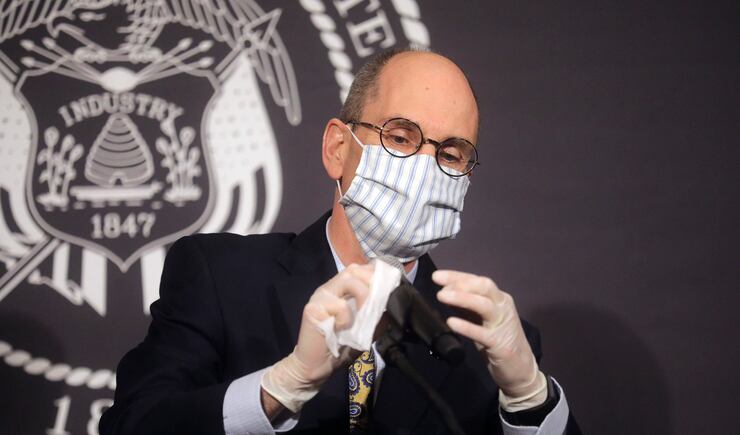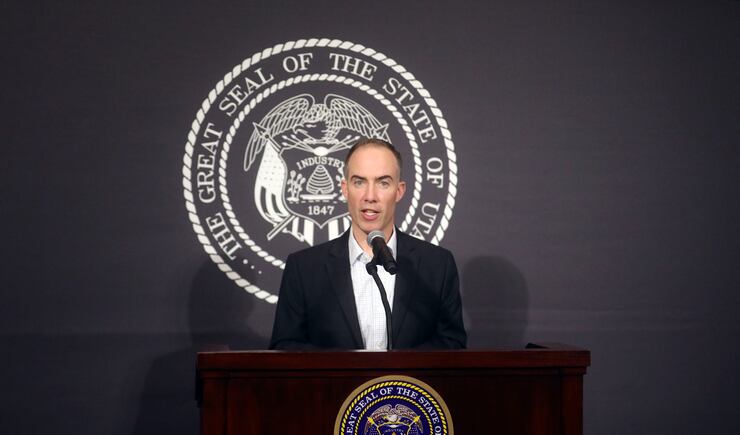SALT LAKE CITY — The state of Utah on Wednesday unveiled a new smartphone application that could help to trace people who might have become infected with the novel coronavirus.
The app, Healthy Together, will cost taxpayers up to $2.75 million in development costs, but it aims to be a more efficient tool to monitor the spread of disease, particularly as things slowly get back to normal.
“Certainly we’re concerned about the ups and downs of COVID-19,” Gov. Gary Herbert said after announcing the app on Wednesday. “Until we have a vaccine to inoculate against it, we’ll always have to worry about a resurgence of the virus.”
He said no matter the number of people who download the Healthy Together app, the data gathered will assist the Utah Department of Health in its contact tracing efforts.
“It’s really about having the right tool in the toolbox,” Herbert said. “These tools will help us slow the spread of the COVID virus and, as much as we can, stop it’s spread.”
The health department reported the number of confirmed COVID-19 cases jumped by nearly 150 to 3,445 in Utah on Wednesday, a 4.5% increase over Tuesday. An additional two deaths were reported as well, marking the loss of 34 lives in the state due to the highly contagious virus.
One of those deaths was linked to an outbreak in a long-term care facility in Salt Lake County, and the other was a Utah County resident who was hospitalized at the time of the death, according to Dr. Angela Dunn, the state epidemiologist. She said both of the deceased were over age 85.
The state has tested 76,460 people, with a positive rate of 4.5%, which is a “slight decrease” from the around 5% positive rate that’s been reported so far, Dunn said.
She said the app is yet another way for Utahns to be able to assess their symptoms and know when and where to be tested, if needed.
Nearly 90,000 Utahns have completed assessment surveys at TestUtah.com, the results of which Dunn said will be used together with those from the new app. She said the more options people have, the better.
“As we move into stabilization and recovery, we’re aware that there is a public health concern — a second wave, if you will,” Paul Edwards, Herbert’s former deputy chief of staff and a member of the state’s COVID-19 task force, said during an unveiling of the application Wednesday. “We hope that aggressive testing and contact tracing will allow us to have a much better picture of where the virus is moving in our communities more quickly.”




He said knowing who is infected or exposed to the virus will help the government respond better and perhaps reduce the need “to run and hide whenever there’s an outbreak.”
“The more people who can use it, the more helpful it will be in avoiding widespread mitigation or widespread stay-at-home directives in the future,” Edwards said.
Once the app is downloaded and an account is set up, the app tracks where a person goes, and should that person later contract the illness and test positive for COVID-19, he or she has the choice to give the health department permission to access that tracking information.
State officials and the developers of the app said personal information will stay private.
“Protecting your data is our utmost concern,” Herbert said. “There are protections in place so people don’t have to worry.”
Of course, the more buy-in, the more successful it will be for the state, said Jared Allgood, co-founder at Twenty, a networking tech solutions company that created the app and has offices in Utah. Allgood said Healthy Together will help to streamline the efforts of the health department.

The health department will continue its own traditional contact tracing methods, though. That involves tedious phone calls and questions from public health workers to determine the whereabouts of people who test positive with COVID-19, which Allgood said are “time-consuming and don’t scale well.”
“It is also filled with holes — holes in people’s memories,” he said. “It’s hard for people to remember where they were two Thursdays ago.”
The technology, Allgood said, is different than automated contact tracing used in some places around the world that requires a lot of people to use it, but involves bluetooth and location data to provide information should the user allow it.
“It will provide a more thorough picture on potential exposures,” Dunn said.
She has said that picture is necessary before the state can lift any social distancing recommendations and requirements.
“I know people are anxious,” Herbert said. “They want to have the economy opened up. And we do, too. We’re on the verge of moving to the recovery phase.”
A breakdown of Utah COVID-19 cases, hospitalizations and deaths by health district:
- Salt Lake County, 1,795; 155 hospitalized; 19 deaths.
- Utah County, 570; 30 hospitalized; 6 deaths.
- Summit County, 341; 31 hospitalized; 0 deaths.
- Davis County, 249; 21 hospitalized; 2 deaths.
- Weber-Morgan, 130; 15 hospitalized; 2 deaths.
- Wasatch County, 123; 6 hospitalized; 1 death.
- Southwest Utah, 70; 9 hospitalized; 1 death.
- Bear River, 55; 10 hospitalized; 1 death.
- Tooele County, 42; 4 hospitalized; 0 deaths.
- San Juan County, 34; 5 hospitalized; 2 deaths.
- TriCounty (Uinta Basin), 9; 1 hospitalized; 0 deaths.
- Central Utah, 20; 1 hospitalized; 0 deaths.
- Southeast Utah, 7; 0 hospitalized; 0 deaths.






